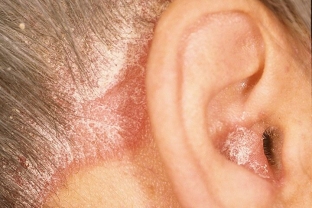Seborrhea – this is one of the varieties of dermatitis that affects mainly the male population of the planet. What are the reasons of the development of this disease? How to properly diagnose and treat this disease? All important facts about seborrheic dermatitis are presented in the article on estet-portal.com.
First, it is worthwhile to understand what seborrhea is. So, this disease affects the skin of the face. The disease occurs as a result of the penetration of the skin mite into the pores, its further active life in the sebaceous layer of the skin. How does this infection get there?
Causes and symptoms of seborrheic dermatitis
In infants seborrhea appears as crusts on the face. The disease develops as a result of contact with an unfamiliar environment. The infant's immune system is still too weak to resist infections.
As a rule, in adults and children, the disease is first noted at the border of hair growth and from the back of the head. The area is also sometimes infected:
- eyebrows,
- eyelashes,
- beards.
Usually this is up to 15 percent of patients.
Symptoms and clinical manifestations of seborrheic dermatitis
In adults, seborrhea appears as purulent acne on the face, increased oiliness of the skin, resulting in clogged pores and blackheads. Symptoms of seborrheic dermatitis of the scalp also include the formation of skin peeling of white or yellowish color . The disease is accompanied by severe and annoying itching.
In addition, if seborrhea is of a protracted nature, it may be accompanied by:
- red spots on the skin,
- layers of scales,
- appearance of pyoderma.
External factors (temperature, stress, physical activity) can increase the manifestation of this disease. There is a change in the hair structure. The hair becomes thinner, breaks and exfoliates at the ends.

Read also: Dandruff again! Why does scalp seborrhea occur
Causes of seborrheic dermatitis
The reasons for the development of seborrhea are numerous. Most often, it becomes a side effect of puberty, which is accompanied by hormonal imbalances (pregnancy, menopause, diabetes mellitus). Endocrine disorders also contribute to this disease. It may be prompted by:
- neoplasms of the genitals and adrenal glands,
- stress,
- nervous disorders,
- wrong skin care,
- aggressive hairdressing techniques,
- violation of hygiene rules or their excessive use.
Seborrhea may be a side effect of drugs, improper diet or fasting.
The main component of a pathogenic nature, which in 90% of cases causes seborrhea – yeast fungus Pityrosporum ovale. Under the influence of an unfavorable environment, it begins to multiply intensively, because the protective functions of the body begin to fall.
Changes the chemical composition of sebum, which has an antiseptic and antifungal effect.
Effective treatment and diagnosis of seborrheic dermatitis
Treatment of seborrhea is not painful, although the disease will have hard to fight. But first it is necessary to accurately establish the diagnosis. Seborrhea can be confused with other dermatological diseases. Often, the diagnosis is established very quickly and does not require sitting in long lines. You will need to make a painless scraping of the husk from the face. In a short time, the name of the bacterium will be accurately identified.
To get rid of seborrheic dermatitis, you will need to follow a diet prescribed by a doctor. Often, she excludes sweets, as they feed the subcutaneous mites. Medications for the treatment of seborrheic dermatitis are selected purely individually. As a rule, a dermatologist prescribes:
- steroid creams
- a course of antibiotics.
In addition, you will need to strengthen your immune system. This will help:
- vitamin complex,
- sports,
- sunbathing in reasonable amounts.
In order for the disease to leave the body forever, it is necessary to thoroughly and carefully cleanse the skin. In rare cases, peeling from the face is removed by a competent doctor. Often, it can be removed by washing the face with a scrub, gently rubbing the skin with a washcloth. The scrub deeply cleanses all pores and eliminates dead skin cells.
Some scrubs contain disinfectants. With its regular use, skin cells begin to renew themselves faster, which ensures healthy and smooth skin.
It is noteworthy that the scrub can be used no more than twice a week. The rest of the time it should be replaced with a special soap or face lotion. Fans of homeopathic remedies can use a decoction of chamomile or oak bark. They relieve itching and disinfect.
Do not lose heart, because for any disease there is always an effective treatment! Read on estet-portal.com.
for the best advice from qualified experts





Add a comment